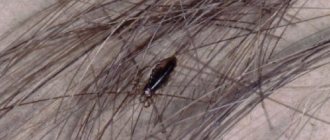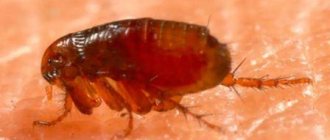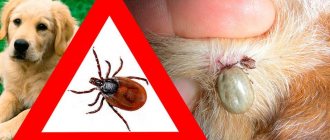Otodectosis or ear mites are a widespread phenomenon that affects not only street cats, but also pets that never go outside. How to get rid of the parasite on your own? Read about it in our article.
You can listen to this article in full on our podcast:
Anything can become a carrier of a disease dangerous to health:
- direct contact with individuals who are carriers of the parasite;
- use of undisinfected accessories after infected animals;
- You can bring tick larvae into your home on the soles of your shoes.
Alternatively, the disease can be inherited - from a cat infected with otodectosis to a kitten.
General signs and symptoms of ear mites:
- the animal is nervous and restless;
- increased body temperature;
- waste products of mites in the form of brown plaque and sulfur accumulate inside the ears;
- The cat scratches its ears with its paws and often shakes its head.
Watch the video: Otodectosis in cats
A little about the structure of a cat's ear
The cat's ear, like the human ear, consists of three sections:
- Outer ear. The outer ear contains the auricle, which the owner will have to inspect for dirt, and the external auditory canal;
- Middle ear. Its “package” includes the eardrum and auditory ossicles, which play one of the main roles in the perception of sound;
- Inner ear. The inner ear contains the vestibular apparatus, which allows the cat to calculate its movements, as well as the structures of the nervous system responsible for recognizing stimuli coming from the environment and from the body itself.
Structure of a cat's ear
A cat's ears are often likened to antennas or radars, which perfectly reflects their functionality. Our pets are able to detect even ultrasonic frequencies that are completely inaccessible to human ears. In addition, the special structure of cat ears allows these animals to determine the source of sound with centimeter accuracy, which is very useful during the hunt. It is this feature that allows cats to capture prey in one jump.
Cats' ears are much more mobile than human ears, which allows them to pick up sound faster.
The similarity with an antenna is also explained by the cat’s ability to turn its ears depending on the sound source at an angle of up to 180 degrees. Due to the fact that the ears can be turned asymmetrically and move in different directions, the cat achieves even greater fullness of sound. In order to control the ears, the cat's body has more than 30 muscles.
Who is exposed to the disease
The first sign of the presence of the disease is a grainy black coating in the kitten’s ears.
When the condition is neglected, internal organs are affected and the body's resistance is reduced. This disease also occurs in adult cats, only it is tolerated in a mild form, since the body has developed a strong immunity to infection. Among domestic animals, not only cats, but also dogs get sick. If there is an infected animal in the house, it is advisable to isolate it from other four-legged fellows. In nature, this disease occurs in raccoons and foxes.
Main symptoms of the disease
- The animal becomes restless. Constant itching in the ear area makes the cat aggressive and nervous.
- Trying to get rid of the constant itching, the animal shakes its head. The head is slightly turned to the side.
- In the places where the tick is located, due to the fact that the vessels are filled with blood, swelling forms.
- Attempting to scratch the ears in any way possible leads to the formation of open scratches and wounds through which infection can enter. The ears become inflamed, fester, and the itching becomes even stronger.
- Brown scabs appear in the ears.
If the above symptoms of the disease occur, you should immediately contact a veterinarian before the disease becomes advanced. If an ear mite infection occurs with complications, the cat's eardrum may burst and the animal may lose hearing. The tick will penetrate first into the middle ear, then into the inner ear. Infection of the meninges will occur. This is expressed in periodically occurring nervous attacks of the animal, as a result of which the animal usually dies.
Ear mites in cats
To prevent this from happening, the cat owner must regularly examine his pet's ears and clean them once a week. It is much easier to prevent a disease than to treat it. After all, at the same time you see the suffering and torment of your pet. If the cause of the disease is death, not everyone can easily bear it.
Do cat ears need care?
As already mentioned, cat ears can remain untidy for a long time even with the most caring owner. It is this body that has received the least attention, and absolutely unjustifiably. The fact is that cats, being very clean animals by nature, do not have the ability to care for their ears on their own and need outside help.
If left uncared for, ear plugs form in a cat's ears, leading to hearing loss.
The accumulation of wax in the ear canals is common to both humans and cats. And if the owner cleans his ears a couple of times a week, then he should think about the cat whose ears have hardly ever been cleaned. Of course, cats can live their entire lives with their ears gradually becoming dirty, and not show signs of dissatisfaction (besides, cats are very stingy in expressing their physical discomfort).
Cats can go for years without having their ears cleaned, which will, however, be harmful to their health.
However, it doesn’t happen once at a time - a lot depends on the very shape of the cat’s ear - some ears are less prone to inflammation and plugs, some more so. If you do not want to one day encounter ear disease in your pet, we advise you to pay attention to the rules of hygiene and start following them as soon as possible.
Prevention measures
The owner of a furry pet should always remember that it is much easier to prevent this disease than to treat it for a long time, exposing the animal to suffering. Prevention of ear scabies includes the following measures:
- Check your cat's ears regularly. It is advisable to carry out this procedure at least once a week. If you notice suspicious discharge, you should immediately take your pet to the veterinarian.
- Promptly remove accumulations of wax and dirt from the animal’s ears.
- Do not have contact with stray cats and dogs.
- Feed your pet a balanced diet.
- Periodically give your furry pet vitamin complexes. It is recommended to coordinate vitamins with your veterinarian.
- Regularly treat the door mat with antiseptic detergents. It is advisable to carry out this procedure daily. To completely eliminate the possibility of your pet becoming infected after contact with this accessory, you need to wean the animal from sitting on it. To do this, simply treat the rug with any product with a citrus scent. You can simply apply a few drops of orange or lemon oil to it.
How often does a cat need ear care?
There is no consensus regarding the frequency of cleaning a cat's ears. Some veterinarians advise performing this procedure almost every day, while others limit themselves to advice to examine your pet’s ears weekly. Of course, not every owner can afford a daily full examination of the cat, so a weekly option will probably seem more acceptable to most people.
The frequency of the procedure for cleaning the pet’s ears is determined by the owner himself, based on the circumstances.
Excessive attention to the ears can also bring discomfort to the cat. Cat ears are more sensitive to touch than human ears. Their structure is vulnerable to careless manipulation, and, even more so, to inept use of ear sticks. Any incorrect or too frequent movement can cause pain to the cat.
In cleansing the ears, as in all other health-improving undertakings, it is important to observe moderation.
Description of the pest
Ear mites living in cats are difficult to notice, since their size is small: from 0.2 to 0.6 mm. The shape of the body is oval, the color is light with yellowness. The pest belongs to the class of arachnids. Ear flares in a cat are not immediately detected if the sink is rarely cleaned of dirt and wax. Given the light color and small size, it will not be possible to notice the parasite in a timely manner.
In some cases, the disease progresses for quite a long time, causing unpleasant consequences (inflammatory processes). This usually happens if the pet owner does not know what ear mites look like in cats and what the signs are.
This is what a tick looks like - photo after magnification under a microscope
Where does the parasite live?
The pest Ototdektes cynotus inhabits the inner side of the ear. It is attracted to moist and fairly warm environments. The auditory canal in the ears of a kitten or an adult pet, as well as the folds of the shell, fit these criteria. Here the parasites feed on skin cells, blood, intercellular fluid and lymph.
Ear parasite is a highly contagious feline disease.
The ear mite in cats, Notoedres cati, usually lives on the outside of the shell. Parasites can also be found on the head. Representatives of the first species considered often go unnoticed for several years. The tick in a cat Notoedres cati is detected faster, since the symptoms of this disease are more pronounced.
Common Ear Diseases in Cats
Based on the information below, you can more confidently identify your pet with a specific disease, or lack thereof. However, remember that you should be careful with home diagnoses. If you can easily get rid of earwax at home, more serious pathologies require medical intervention.
Ear diseases are not always obvious to the owner, but often have dangerous consequences
Hematoma
In the strict sense of the word, a hematoma is not a disease, being the result of external mechanical damage or bruise. As a rule, a hematoma appears on the inner surface of the animal’s ear, less often on the outer surface. The damaged ear swells, hangs down and increases slightly in size. When palpated, the swelling is significantly warmer than the rest of the ear. If left untreated, the hematoma may rupture when the cat tries to scratch it and lead to cartilage necrosis.
With a hematoma, the size of the ear increases noticeably
Symptoms
- The pet constantly shakes its head or holds it at a certain angle;
- The pet actively scratches the damaged area;
- The owner's attempts to examine the ear cause attacks of aggression in the cat.
Treatment
If you managed to see a veterinarian before 48 hours have passed since the bruise, he will bandage the ears and apply ice. Also, the pet is prescribed special healing antibacterial ointments. In advanced cases, the hematoma is opened and the thickened blood is removed. The cavity is washed with novocaine and antibiotics.
The bandage is effective only if you contact a veterinarian in a timely manner.
Lymphextravasate
This disease is similar in symptoms and course to hematoma, but is completely different from it in terms of causes and methods of treatment. Lymphatic extravasation involves damage to the lymphatic vessels, as a result of which the lymph flows beyond them.
With lymphatic extravasation, the bubbles with liquid are opened, and the ear cavity is treated with special preparations
After opening the vessel, a bubble with a transparent shell is found on the animal’s ear. Its color varies from soft pink (matching the color of the skin inside the ear) to reddish (due to the mixing of lymph with blood secretions). The bubble should not be confused with inflammation: firstly, it should not be hot to the touch (maximum - warm); secondly: the animal’s temperature should not rise.
Symptoms
- The cat tries to reach the bubble with its paw and open it;
- The cat often and intensively rubs against the owner's legs and other objects, trying to comb its ear;
- The pet’s very mood changes: it becomes nervous and irritable, sometimes apathetic and lethargic.
Opening of lymph bubbles should only be performed by a specialist
Treatment
The liquid from the formed bubbles must be pumped out using a syringe; opening the bubble at home is strictly prohibited. In advanced cases, surgical operations are performed that involve making an incision in the skin and carefully removing any remaining lymph from the cavity.
Necrosis of the auricle
Necrosis is not a specific disease, but an advanced stage of many possible pathologies. It appears both as a result of prolonged compression of the ear, and as a result of the opening of untreated hematomas, lymphatic extravasations and abscesses that infect the auricle with pathogenic microflora.
At home, necrosis of any organs occurs very rarely
The opening of inflammation leads to the gradual death of healthy tissue and the formation of a large number of ulcers that grow in size. During necrosis, the cartilage becomes black due to impaired blood supply. In the later stages, the ear becomes deformed, and the process of decay itself is accompanied by a characteristic unpleasant odor. Lack of treatment threatens the progression of necrosis and its spread to brain tissue, which leads to death.
Symptoms
Necrosis has no specific symptoms and depends on the disease that led to it.
Treatment
Getting rid of necrosis can only be radical: partial or complete amputation of the ear is carried out. In the case of partial amputation, when necrosis has not yet affected the entire ear, only the damaged area is affected.
Advanced necrosis of the auricle leads to the need for amputation of the pet's ear
Benign formations
These formations do not directly threaten the life of the pet, however, in the absence of the owner’s response, they tend to grow, leading to partial or complete deafness of the cat. Such tumors include papillomas and fibromas. They usually occur due to weakened immunity and are common among older individuals whose bodies are not capable of the same level of protection.
Papillomas can occur both inside the ear and at its base
Symptoms
- The cat shows anxiety, meows often and loudly for no reason;
- The cat makes clumsy, uncoordinated movements that were previously unusual for him;
- The cat tilts its head to the side (towards the affected ear).
Treatment
Papillomas are usually removed surgically. In some cases, they try to inject pets with novocaine intravenously or under the base of the wart, which leads to its reduction and even disappearance. Among other things, the pet is prescribed immunostimulants and vitamin complexes that prevent the emergence of new formations. At the time of treatment, papillomas are lubricated with antiseptic ointments.
Benign formations are cut out with a scalpel at the request of the owner
Otodecosis
Otodecosis is provoked by a certain type of mite, which is localized in the auricle and external auditory canal. It is not possible to notice the tick itself, therefore we can only suspect this pathology based on the consequences of its life activity. Otodecosis is transmitted to a pet from infected individuals, which can be not only cats, but also dogs, ferrets, and arctic foxes.
Otodecosis is easily recognized due to its characteristic dark red crusts.
Ears in which mites have settled quickly become crusty and begin to emit an unpleasant odor. Due to the fact that the parasites feed on the skin of the animal, the ear canals are gradually destroyed. Advanced variants of the disease involve rupture of the eardrum and the rush of mites to the brain. Animals of all ages are susceptible to odecosis. You can read more about ticks in cats on our portal.
Symptoms
- The pet shows anxiety and nervousness;
- The pet tilts its head and shakes it, trying to get rid of parasites;
- Ear scratching leads to profuse bleeding and scratching visible to the naked eye at the base of the ears.
Treatment
Before any measures are taken, the ear is completely cleaned, then special drugs are instilled into it (Amitrazine, Tsipam, Aurican, etc.). Drops for the withers (Frontline, Stronghold) are also used. During treatment, it is advisable to isolate the pet from other animals in the house, if any. To check the success of the treatment, a second scraping is taken from the animal's ear.
Amitrazine is available in the form of ear drops, which should be instilled into the pet for a long time.
Otitis
Otitis media, like necrosis, is a consequence of a number of other untreated diseases, allergies or fungi. Immunodeficiency can also cause otitis media. Otitis occurs in both chronic and acute phases. Localized on all types of ears according to depth (outer, middle, inner). The further otitis media penetrates, the more difficult it is to cure it and cope with the consequences.
Chronic otitis media is common both among stray cats and among domestic cats due to its inconspicuous nature.
The most dangerous is otitis media that occurs without pronounced symptoms. Redness of the skin of the ear may be barely noticeable, and other symptoms are often absent, until a sharp deterioration in the pet’s health. Perforation of the eardrum in such cases comes as a complete surprise to the owners. However, the most dangerous complications of otitis media are meningitis and possible hearing loss. Inflammation affecting brain tissue can lead to other serious brain diseases.
Symptoms
- The pet loses its appetite, does not take part in games and avoids communicating with the owner;
- In the case of purulent otitis, whitish discharge periodically flows from the pet’s ears, indicating the opening of ulcers;
- The cat stops turning the affected ear when hearing sharp sounds;
- Sometimes otitis media is accompanied by paralysis of neighboring muscles - a sick pet may have a sagging eyelid, lip or ear itself;
- The cat scratches its ear until it bleeds and often shakes its head.
Inflammation of the cat's ear due to otitis media
Treatment
The fight against otitis occurs with the help of broad-spectrum antibiotics or antifungal medications (depending on the provoking disease). The veterinarian will prescribe a special solution for rinsing the ears at home.
How to avoid tick infestation
Check your pet's ears regularly and if they become dirty, wipe them with a damp cloth.
What cat owner would be happy if his beloved pet gets sick? This is always painful, because the animal must be properly cared for, and medications must be given systematically. But it’s much more scary if the infection is really serious. This can be caused by ear mites in cats. That is why you need to know how to get rid of ear mites, which drugs are recommended to be used in the early stages of the disease, and which can be used in much more advanced cases.
If you are thinking about which medicine for ear mites in cats is worth purchasing, the choice depends on several factors, for example, the age of your cat or the degree of progression of otodectosis (a disease that occurs due to bites of a tick infected with a virus). Drops, for example, “Stronghold,” have the widest spectrum of action. They contain a potent antibiotic that not only removes ticks, but also neutralizes their eggs, as well as fungus, worms, inflammation and various infections.
Aversectin ointment also helps against ear mites. It is placed in the cat's ear with a special spatula. As a rule, it is recommended to lubricate your pet's ears twice a day. But in order for the remedy for ear mites in cats to really give the desired effect, you should follow some recommendations:
- Drying pustules appear in the ear canal. These are the ones you need to get rid of before applying ointment or drops. To do this, take a cotton swab and soak it in a 2% alcohol camphor solution. Wipe your cat's ears with the swab;
- when you apply the ointment or drop the product into your ear, gently massage it at the base - this way the drug will quickly fill all problem areas, absorb and begin to act;
- Be sure to observe the frequency of use of medications, otherwise you should not expect a full recovery.
Medicinal drops and ointments are effective means to combat ticks in cats.
Types of cleanings
Keep in mind that there are different types of cleanings depending on the condition of your cat's ears. If preventive cleansing , then the owner can easily handle it himself at home. If we are talking about therapeutic washing to remove traces of tick activity, for example, then we will need the help of a veterinarian and special medications. Next, we talk specifically about preventive ear cleaning, which does not require in-depth knowledge or training to carry it out.
Deep cleaning of a pet's ears in case of ear plugs or any diseases is carried out only in a veterinary clinic
Choosing ear mite drops for cats
Drops for otodectosis on the pharmaceutical market are represented by a wide range of products. Veterinarians most often recommend the following drugs for use: Amitrazine, Frontline, Surolan, Akromectin, Bars, Tsipam.
What exactly to prefer is up to you to decide, taking into account the recommendations received from the veterinarian who examined your pet.
Particular attention should be paid to the choice of medicine for a pregnant cat or kitten. Follow the advice of your veterinarian. Before using the drug, be sure to read the instructions and do not violate the dosage.
Cleaning a cat's ears - step-by-step instructions
- Position the cat so that it is positioned sideways to you and sit it on your lap. If necessary, grab it by the withers or wrap it in a towel;
- Carefully turn out the auricle and inspect its contents for the presence of dirt, inflammation and crusts;
- If you notice heavy discharge, take a swab and dip it in the chlorhexedine solution. Squeeze it out and walk along the inside of the ear, without pressing or going deep inside;
Gently lift the skin at the base to blot the surface of the ear with the swab
- If more wax has accumulated in your pet's ears, drop saline solution into the ear canal and massage it so that the liquid flows inside. After instillation, hold the cat for ten minutes to ensure that the solution has reached its target;
- If the solution used is in a bottle, then lower its tip two to three millimeters into the ear canal and squeeze out the required number of drops;
- When using cotton swabs, do not try to push them in as far as possible. In the inner ear, as a rule, wax does not accumulate due to the presence of the eardrum, therefore there is nothing special to clean “in depth”;
- When working with cotton swabs, make sure that your movements are directed outward and not inward, otherwise you will only push the sulfur deeper, from where it will be even more difficult to get it out;
Movements made with a cotton swab must be carried out according to strict rules
- When you are sure that the drops have successfully passed inside, wipe the animal's ears with a towel and reward him with a treat for his outstanding achievements.
Keep in mind that too frequent cleaning of your pet's ears leads to damage to the ear microflora, which is also fraught with various diseases. The frequency of cleanings depends on the breed and should be discussed with your veterinarian.
By the way! Hairless cats produce more earwax and require frequent cleaning.
Main features
The cat owner can easily notice the symptoms of ear mites by her changed behavior. First of all, the ears are constantly itching, the animal becomes very restless, often shakes its head, and noticeable scratching forms in a short time. Incessant itching causes constant meowing, sudden movements, bleeding wounds and abrasions appear. The cat's appearance noticeably deteriorates; the villi near the ears become moist and stick together. If such changes are detected, it is recommended to carefully examine the animal's shells.
The active activity of the mite is noticeable upon visual inspection of the outer part of the hearing aid. There is sticky, loose fur, and the presence of scabs and crusts. If you turn the ear away, dark brown spots are found inside, indicating the release of purulent masses. They often emit a foul odor, which is why they differ from ordinary earwax.
When bowhead syndrome is observed, we can safely talk about a complicated form of infection. At the same time, the animal feels unwell, its general condition sharply worsens, its appetite sharply decreases or disappears altogether, constant nervousness and severe exhaustion are observed. It is very dangerous if, without treatment, the inflamed process spreads to the meninges. When such a complicated stage occurs, frequent nervous disorders in the form of convulsions, convulsions, and seizures make themselves felt. In most of these cases, the result is death.
Understanding the danger of the presence of a tick on a pet’s body, when the first symptoms of pathology are detected, a person should contact a veterinary clinic. A specialist will quickly determine the development of otodectosis. In addition to the usual clinical examination using specialized instruments, additional diagnostic measures are carried out. Exudate taken from the auricle is subject to laboratory examination under a microscope.
Features of cleaning a kitten's ears
Many veterinarians claim that a kitten's ears are too tender for massive cotton swabs and swabs. However, it is still necessary to clean your pet’s miniature ears of accumulated secretions and dirt. For this procedure, they usually use a saline solution in a bottle, which is smoothly poured into the pet’s ears. First, three to five drops are instilled on the inner surface of the ear, after which another six to seven drops are instilled into the ear canal.
Cleaning your kitten's ears should not involve the use of harsh materials.
After instillation, the kitten’s ears are massaged for a couple of minutes to improve fluid passage. It is necessary to massage the ears at the base - this will distribute the saline solution more evenly. At the end of the procedure, put the kitten down and let him shake out the wax and secretions that have come out of his ears thanks to the drug. After this, wipe the kitten's ears with a towel to get rid of any remaining liquid.
Video: Cleaning a kitten's ears
Prevention measures
The following preventive measures are applied to the animal to prevent parasites:
- Careful hygiene is required.
- Prevention of ear mites in cats involves limiting contact with street animals. This applies to both the pet and its owner.
- You should carefully clean your kitten’s ears and always monitor their condition to determine when help is needed. With regular maintenance, the problem will be detected quickly.
- Many parasites are neutralized by vaccinations. This is not a guarantee, but it is necessary to carry out a preventive examination and get vaccinated in a timely manner. This way the body will learn to cope with classic problems more easily.
Some owners don’t know how and what to clean their cat’s ears at home. It is best to use cotton swabs. For a healthy pet, you can use dry ones, and for a cat affected by ticks, soaked in a disinfectant. Additionally, there are drops in each ear, both therapeutic and preventive.
The main thing is to remember very simple rules. Prevention is always better than disease, and a professional doctor is better than traditional medicine. However, home remedies still have the right to life, but only at the very beginning or as part of a complex.
Ear mites are not a tragedy for cats, but if left unchecked, they can quickly become one. The animal becomes part of the family and any accident or illness with it is difficult to survive. You just need to deal with parasites correctly.
Characteristic symptoms with photos
According to statistics, ear scabies most often affects kittens under 6 months of age and older cats with weakened immune systems. It is not difficult to recognize otodectosis. It is enough to carefully observe the furry pet. The following signs indicate infection:
- Anxiety. Parasites cause a cat a lot of discomfort. Trying to shake ticks out of his ears, the pet constantly shakes his head, rubs his ears against walls and pieces of furniture, and meows pitifully, as if asking the owner for help. When the animal makes active movements of its head, liquid may spray out of the ears.
- Increased body temperature. In a sick pet, parasites can provoke the development of hyperthermic syndrome. At the same time, he looks lethargic and depressed.
- Nervous disorders. The disease makes the animal nervous, irritable and sometimes even aggressive.
- Discharge from the ears. The formation of accumulations of dark brown, foul-smelling fluid in the ears (see photo) is the main symptom of this disease. Otodectosis is also associated with increased secretion of wax, bleeding scratches, redness and irritation of the skin lining the inside of the auricle. When purulent exudate flows from the ears, the hair sticks together. In advanced cases, sick pets have significantly worse hearing.
Self-detection of such a disease can be complicated by the specific position of the ears. In fold-eared cats, it is not so easy to determine the condition of the ear. To prevent the disease from progressing to a severe stage, it is recommended to regularly examine your pet’s ears.











